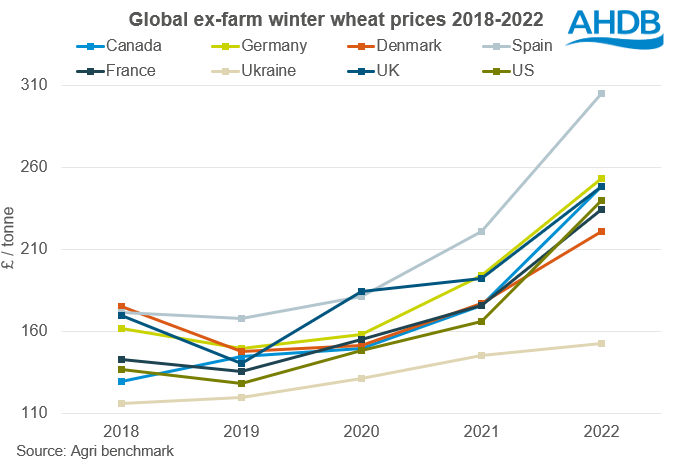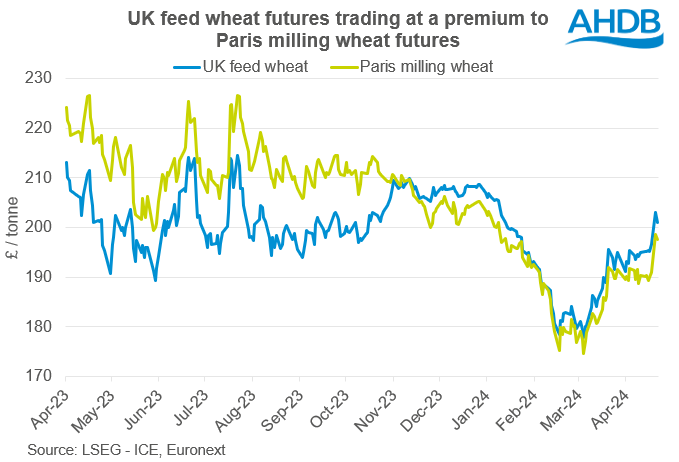How do UK ex-farm winter wheat prices compare internationally? Grain market daily
Wednesday, 24 April 2024
Market commentary
- UK feed wheat futures (May-24) closed at £177.90/t yesterday, down £3.05/t from Monday’s close. The Nov-24 contract fell £2.00/t over the same period, ending the session at £200.95/t.
- While domestic wheat futures reached their highest point since January on Monday, prices eased in line with European markets yesterday. Wheat prices had risen on the back of concerns over dry weather in Russia and parts of the US, though markets subsided yesterday as traders awaited a clearer picture of the impact of the adverse weather (LSEG).
- Paris rapeseed futures (May-24) fell €5.75/t yesterday, closing at €450.75/t. New crop futures (Nov-24) ended the session at €465.75/t, down €1.00/t over the same period.
- EU rapeseed futures moved in the opposite direction to US soyabeans yesterday. Crop condition in Europe is now reportedly above average according to LSEG. The 2024/25 EU rapeseed production figure was kept at 20.5 Mt this morning, despite mixed weather patterns over the last two weeks.
How do UK ex-farm winter wheat prices compare internationally?
As highlighted in the first and second articles of this series, AHDB submits data representing a range of ‘typical’ UK farms into an international benchmark database each year. With this data we can compare and analyse how UK cash crop production compares to key competitors around the world.
This article will focus on farm income, by comparing ex-farm winter wheat prices using data back to 2018. The price for each country is an average of all the farms entered for that nation and includes a range of milling and feed wheat. As in previous articles in this series, the countries in this analysis include Canada, Germany, Denmark, Spain, France, Ukraine, the UK and the US.
UK fourth highest ex-farm price globally
Averaging £248.48/t, in 2022, the UK had the fourth highest ex-farm price for winter wheat, behind Spain (£305.01/t), Germany (£253.25/t) and Canada (£248.84/t). Looking back, apart from 2019, the UK’s ex-farm prices have consistently been higher than the average of all included nations.
Unsurprisingly, prices in 2022 were overall much higher than the five-year average and the year prior. All countries in the analysis, aside from Ukraine, saw at least a 25% climb on the year, with prices spiking mid-season on the back of the outbreak of war in Ukraine.

As could be expected, Ukraine did not see the same increase in ex-farm prices for harvest 2022. With Russian attacks targeting key seaports (such as Odesa), the country struggled to continue exporting at the usual pace. As such, a surplus of grain in the country meant that despite global spikes, Ukrainian prices saw minimal movement.
Spain saw much higher ex-farm prices from the 2022 season than the other countries in the comparison. In three out of the last five years, Spain has averaged the highest ex-farm winter wheat price. The widened gap between Spain and the other nations in 2022, is likely due to the poor grain harvest which the country endured that season as a result of drought conditions.
Looking ahead
We can look at current futures prices to get an idea of how domestic prices for the upcoming harvest may compare to global markets. Historically, Paris milling wheat futures have generally traded at a premium to UK feed wheat futures. However, in November 2023, domestic wheat futures (Nov-24) began trading at a premium to Paris milling wheat futures (Dec-24), suggesting a slight shift in our relationship to the global market.

While parts of western Europe have also struggled with poor planting conditions this season, it seems that the extent of concerns over the UK crop have pushed our price relatively higher. Of course, domestic prices will continue to track general global price direction. However, our trading relationship to the continent will be something to watch over the next couple of months as we gain a clearer picture on harvest 2024.
The final article of this series will explore the key factors driving profitability internationally, and is due to be published in the coming weeks.
Sign up to receive the latest information from AHDB.
While AHDB seeks to ensure that the information contained on this webpage is accurate at the time of publication, no warranty is given in respect of the information and data provided. You are responsible for how you use the information. To the maximum extent permitted by law, AHDB accepts no liability for loss, damage or injury howsoever caused or suffered (including that caused by negligence) directly or indirectly in relation to the information or data provided in this publication.
All intellectual property rights in the information and data on this webpage belong to or are licensed by AHDB. You are authorised to use such information for your internal business purposes only and you must not provide this information to any other third parties, including further publication of the information, or for commercial gain in any way whatsoever without the prior written permission of AHDB for each third party disclosure, publication or commercial arrangement. For more information, please see our Terms of Use and Privacy Notice or contact the Director of Corporate Affairs at info@ahdb.org.uk © Agriculture and Horticulture Development Board. All rights reserved.


